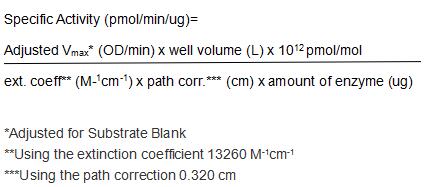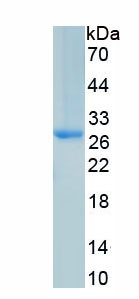Active Complement Factor D (CFD) 

CF-D; DF; PFD; ADN; Adipsin; Properdin Factor D; C3 convertase activator
- UOM
- FOB US$ 212.00 US$ 530.00 US$ 1,060.00 US$ 3,180.00 US$ 7,950.00
- Quantity
Overview
Properties
- Product No.APB833Ra01
- Organism SpeciesRattus norvegicus (Rat) Same name, Different species.
- ApplicationsCell culture; Activity Assays.
Research use only - DownloadInstruction Manual
- CategoryImmune molecule
- Buffer FormulationPBS, pH7.4, containing 0.01% SKL, 5% Trehalose.
- Traits Freeze-dried powder, Purity > 95%
- Isoelectric Point6.6
Sign into your account
Share a new citation as an author
Upload your experimental result
Review

Contact us
Please fill in the blank.
Activity test

Complement Factor D (CFD) is a serine protease that catalyzes the initial proteolytic step in the alternative pathway of complement. Expressed in adipose tissue at high levels, factor D is also known as adipsin. It is an exceptionally specific protease and the only known protein substrate is factor B in complex with C3. Factor D protease activity is regulated by reversible conformational changes, which differs from the majority of serine proteases whose regulation involves either activation by processing of the zymogens or inactivation by binding of the inhibitors. Compared to its physiologically important proteolytic activity, factor D has much lower activity toward synthetic peptide substrates. However, thioester substrates have been routinely used for assessing factor D activity. The full-length (amino acid residues 1-263) of rat CFD was expressed which activity was measured by its ability to cleaves a thioester substrate Z-Lys-SBzl•HCl. The reaction was performed in 50 mM Tris, 1 M NaCl, pH 7.5 (Assay Buffer), initiated by addition 50 μL of various concentrations of CFD (diluted by Assay Buffer) to 50 µl substrate mixture of 0.2mM Z-Lys-SBzl•HCl and 0.2 mM DTNB. The final well serves as a negative control with no CFD, replaced with 50 μl assay buffer. Then read in kinetic mode for 5 minutes at an absorbance of 405 nm. The specific activity of recombinant rat CFD is > 10000 pmol/min/µg.
Usage
Reconstitute in 10mM PBS (pH7.4) to a concentration of 0.1-1.0 mg/mL. Do not vortex.
Storage
Avoid repeated freeze/thaw cycles. Store at 2-8°C for one month. Aliquot and store at -80°C for 12 months.
Stability
The thermal stability is described by the loss rate. The loss rate was determined by accelerated thermal degradation test, that is, incubate the protein at 37°C for 48h, and no obvious degradation and precipitation were observed. The loss rate is less than 5% within the expiration date under appropriate storage condition.
Increment services
-
 BCA Protein Quantification Kit
BCA Protein Quantification Kit
-
 Molecular Mass Marker for Protein
Molecular Mass Marker for Protein
-
 Monoclonal Antibody Customized Service
Monoclonal Antibody Customized Service
-
 Polyclonal Antibody Customized Service
Polyclonal Antibody Customized Service
-
 Protein Activity Test Experiment Service
Protein Activity Test Experiment Service
-
 Electrophoretic Mobility Shift Assay (EMSA) Experiment Service
Electrophoretic Mobility Shift Assay (EMSA) Experiment Service
-
 Buffer
Buffer
-
 Lentivirus Packaging Experiment Service
Lentivirus Packaging Experiment Service
-
 Adenovirus Packaging Experiment Service
Adenovirus Packaging Experiment Service
-
 Real Time PCR Experimental Service
Real Time PCR Experimental Service
-
 Spike RBD Protein (S-RBD)
Spike RBD Protein (S-RBD)
-
 Protein G
Protein G
-
 Protein A
Protein A
Citations
- Relationship between serum adipsin and the first phase of glucose‐stimulated insulin secretion in individuals with different glucose tolerancePubmed:29432659
- CORRELATION OF INCREASED SERUM ADIPSIN WITH INCREASED CARDIOVASCULAR RISKS IN ADULT PATIENTS WITH GROWTH HORMONE DEFICIENCYPubmed: 30657359
- Association between plasma adipsin level and mild cognitive impairment in Chinese patients with type 2 diabetes: a cross-sectional studyPubmed: 31651303
- HFD-induced hepatic lipid accumulation and inflammation are decreased in Factor D deficient mousePubmed: 33067533
- Body fat distribution and circulating adipsin are related to metabolic risks in adult patients with newly diagnosed growth hormone deficiency and improve after …Pubmed: 33254428
- Association between thrombotic microangiopathy and activated alternative complement pathway in malignant nephrosclerosis33367879







